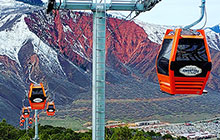Glenwood Caverns and Historic Fairy Caves, a living cavern system that is a part of Glenwood Caverns Adventure Park near Glenwood Springs, Colorado, contains hundreds of cave formations ranging from tiny to gigantic. Visitors to Glenwood Caverns can see the formations and learn the scientific theories of the creation of the formations, known as speleothems.
- Stalactites, the most well-known formations, hang down from the ceiling, are usually carrot-shaped, and are the result of billions of droplets of calcite-bearing water. As each drop runs down to the tip of the Stalactite, it leaves a minuscule bit of calcite. The calcite sticks to the Stalactite, adding one tiny building block to the formation.
- Stalagmites are the mirror opposites of Stalactites; they grow up, not down. Stalagmites generally are shorter and thicker than their companion Stalactites on the ceiling above. They are thicker because the falling water droplets tend to splash and spread out as the Stalagmites gradually build up from the floor of the cave. Both Stalactites and Stalagmites grow at an incredibly slow rate, roughly the width of a human hair each year. The Stalactites and Stalagmites visitors see in Glenwood Caverns are hundreds of thousands of years old, maybe even millions.
- Soda Straws are a type of Stalactite that hang from the ceiling in long, hollow tubes which look very much like a soda straw. The water drops deposit calcite around their outer edges, forming a ring on the ceiling of the cave. As the rings lengthen, they form hollow tubes. Each drop of water travels down the inside of the soda straw and deposits calcite on the open end of the straw. When a Soda Straw becomes plugged, the water continues to drip from the ceiling, gradually covering the long, slender straw and building up the calcite deposits to become Stalactites.
- Cave Bacon is formed when the water drops flow down a sloped ceiling and build up calcite in a thin line before dropping to the floor. As the formations grow, the new rock folds and curls, creating graceful curves. Some of these thin formations are colored by stripes of iron oxide or other organic solutions giving them the look of gigantic strips of bacon. The Cave Bacon formations in Glenwood Caverns are very realistic and look good enough to eat.
- Cave Popcorn is formed by the slow seeping of water from the walls of the caverns. The knobby formations resemble popcorn or clusters of grapes. Because Cave Popcorn is one of the few cave formations that can form both in the open air and under water, the current scientific theory is that the calcite-laden water is forced out of the walls from internal pressure.
- Flowstone formations are created when water oozes over the cave walls or floors and the calcite in the water gradually hardens into a smooth, shiny surface. Hardened calcite itself is colorless, but Flowstone can be colorful if minerals from the soil and rock add new hues. Flowstone formations look like melted cake icing or a frozen waterfall.
- Helictite formations are created similarly to Soda Straws, from water flowing through a small central channel. However, pressure and air movement cause these formations to twist at odd angles. The word Helictite comes from the Greek word helix, which means to spiral. (e.g., the diagram of DNA is a spiraled double helix.) Helictites are crystalline and cream-colored or white. They can be very fine, almost hair-like, or thicker, branching out like elk antlers. Sometime Helictite formations resemble a bowl of spaghetti.
- Frostwork (Aragonite Crystals) is created when calcite-laden water that holds a high concentration of magnesium evaporates. The magnesium inhibits the buildup of calcite, thus allowing Frostwork to form. The crystalline formation grows needles in random directions, resembling the naked branches of a tree or cactus. The glittery Aragonite Crystal formation resembles Rocky Mountain frost on a pine tree. Frostwork formations are the most intricate and fragile of all cave formations.
- Gypsum Flowers grew on the walls of Glenwood Caverns when water pressure within the walls forced its way into the air of a dryer portion of the caverns. The calcium sulfate in the water is deposited and hardens into gypsum. Changes in the water flow rate cause the Gypsum Flower petals to curve.
- Moonmilk is a combination of carbonate materials, including calcite and gypsum, which form very fine crystals. These crystals are a semi-liquid, cheese-like substance and Glenwood Caverns has Moonmilk on the floors, walls, and ceilings of the big rooms. This white formation is pasty when wet and crumbly and powdery when dry. Because it breaks easily, visitors and cavers can easily damage Moonmilk Visitors to Glenwood Caverns are cautioned not to touch anything, because the slightest touch will harm the delicate formations, especially Moonmilk. Legend says that the Native American inhabitants of this area used Moonmilk for medicinal purposes, making a poultice to stop bleeding, to bring down fevers, to cure diarrhea, and to ease upset stomachs.
- Cave Clouds are smooth layers of minerals that coat boulders on the walls and ceilings of the caverns and create fascinating formations that resemble puffy clouds. The Cave Clouds in Glenwood Caverns cover a portion of the walls and ceilings in the historic section.
Visitors can see many of these cave formations within Glenwood Caverns. Throughout Glenwood Caverns’ history cavers, owners, and tourists have named some of the specific formations visitors enjoy.
- Jabba the Hutt is a fat round Stalagmite that resembles the Star Wars character. Jabba the Hutt holds court near the visitor platform in King’s Row. Perhaps he is squatting beside the platform to keep his guard up in case Luke Skywalker should be among the tourists.
- The Wedding Cake is a Stalagmite festooned with icing and frills with a covering of Flowstone that resembles a multilayer white wedding cake.
- The Bedroom is a large room that is a favorite place for cavers to sleep when they are exploring and restoring the caverns.
- The Chess Pieces in the King’s Row Room are enormous standing Stalagmites that look like the King, a Pawn, and a Rook in a row on a chessboard. Visitors, who are more than 158 feet underground at that point, can see the Chess Pieces from a safe platform with hand railings.




